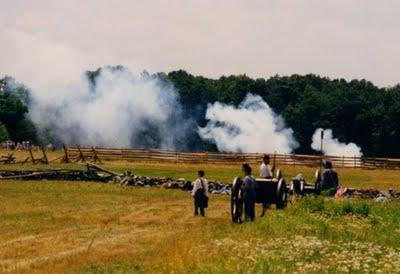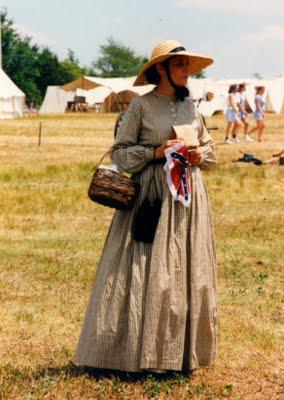
History was repeating itself--or so it seemed. This time, however, the soldiers and ladies dressed in 1860's attire were actors playing parts. Observers sat safely on bleachers or stood along the sidelines while the action was narrated over a loudspeaker. (The announcer also filled us in on background information--a benefit for people like me who were a bit rusty on Civil War history.)
KA-BOOM! The first cannon volley thundered across the field and smoke billowed skyward. Soldiers marched forward and fell in battle. KA-BOOM! KA-BOOM! KA-BOOM! For nearly an hour the cannons boomed and muskets fired with deafening realism. When the attack was over “victims” jumped up unharmed and the soldiers, sweltering in their authentic woolen uniforms, guzzled Gatorade.
Pickett's Charge

For my family, watching and talking with the reenactors was an ideal opportunity to visualize history as it happened. Dressed in authentic clothing and living in a tent encampment for the long weekend, the reenactors at Herr’s Ridge lived and breathed the history of the Civil War era. Although there are excellent exhibits at the National Park Visitor Center and other museums in town nothing makes history more real than meeting people who have incorporated it into their lives.
What the Women Wore

We chatted with two women whose husbands had been on the battlefield. Both said they had been drawn into reenacting by their husbands’ military interest but once “bitten by the bug” it was hard to resist becoming an enthusiastic participant. Weekends such as this one were family events and included children who were also dressed in period clothing.
When we asked about the authenticity of women and children at this event we got a short history lesson on women’s participation in the Civil War. While most women stayed at home during the Civil War, maintaining the family farm or business while their husbands were fighting, many wives followed the camps, especially if their own homes had been destroyed by the war and they had no relatives to take them in. In a few cases, women disguised themselves as men, and fought as soldiers. If they were discovered, they were evicted from camp and lucky not to be shot for treason.
Sutlers and Vendors
Vendors also sold women and children’s clothing, household goods and toys of the period. In a booth that specialized in jewelry I learned another new word, “chatelaine,” an ornamental clasp that the mistress of a house wore at her waist and which had hooks for attaching keys to the pantry, a watch, and perhaps a small purse. The chatelaine we examined was of chased silver and clearly meant as a status symbol as well as a practical item.
Steeping Yourself in History
If you like your history dramatized, you should plan your trip to Gettysburg so that it includes a summer weekend. Reenactments of various kinds of Civil War events occur on almost every weekend between May and October. Another way to put drama into your trip is to tour the battlefields by trolley. The tour guide plays the part of several Civil War characters. (We chose instead to buy the Auto Tape Tour at the National Civil War Wax Museum, 297 Steinwehr Avenue, for a self tour so that we could visit at our own pace.)
Getting there: Fly to Harrisburg, Pennsylvania and then go by car to Gettysburg. (South on 15 from Harrisburg, exiting on US 30 to Gettysburg. A scenic 39 mile drive.)
Current Gettysburg information: Gettysburg go to http://www.gettysburgaddress.com. Click on reenactments for current information.


